Printed Circuit Boards (PCBs) are the backbone of modern electronics, and they are used in a wide range of devices, from simple gadgets to complex machinery. Due to the increasing demand for smaller and more complex electronic devices, PCBs have become more densely packed, making them more susceptible to damage from environmental factors such as moisture, dust, and corrosion. Conformal coating is a process that helps protect PCBs from these environmental factors by applying a thin protective layer over the board’s components.
Conformal coatings are applied to the surface of a PCB to protect it from dust, moisture, and other environmental factors that can damage the components. There are several types of conformal coatings available in the market, each with its unique properties and characteristics. The type of conformal coating used depends on the application, the environment in which the PCB will be used, and the level of protection required [1].
This article will provide an overview of the different types of conformal coatings used to protect PCBs. We will discuss the advantages and disadvantages of each type of coating, as well as their properties, such as chemical resistance, UV stability, and dielectric strength. This article will also cover the application process for each type of coating and provide tips on how to choose the right conformal coating for a specific application.
What Are Conformal Coatings?
The primary function of conformal coatings is to protect electronic assemblies from moisture, dust, salt spray, temperature extremes, and other environmental stressors that can cause performance issues or even failure of the electronic components.
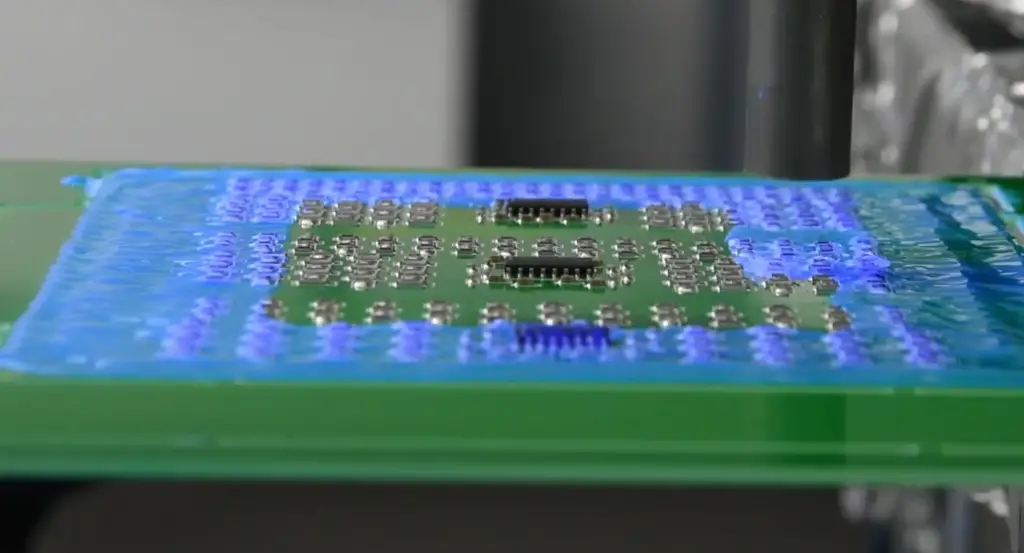
Benefits of Conformal Coating
One of the key benefits of conformal coatings is their ability to provide protection without interfering with the electrical performance of the electronic components. The coatings are typically very thin, ranging from 0.001 to 0.005 inches, and they are designed to maintain the electrical properties of the components while providing a barrier against environmental stressors [2].
Conformal coatings are used in a wide range of applications, including automotive, aerospace, military, medical devices, and consumer electronics. They are particularly important in harsh environments where electronic assemblies are exposed to moisture, dust, salt spray, and other contaminants.
Why Do You Need a Conformal Coating?
Conformal coatings can be made from a variety of materials, including acrylic resin, urethane resin, silicone resin, epoxy resin, and poly-para-xylene (Parylene). Each type of material has its own unique properties and benefits, and the choice of coating material will depend on the specific requirements of the application.
Conformal coatings are typically applied using a spray, dip, or brush method, depending on the size and complexity of the assembly. After the coating is applied, it is cured to create a durable, protective layer. Curing methods include heat, UV light, and moisture, depending on the type of coating material being used.
Which Does Industry Require Conformal Coatings?
Conformal coatings are widely used in various industries where electronic components and printed circuit boards (PCBs) are exposed to harsh environmental conditions that can cause damage and reduce their performance. Some of the industries that require the use of conformal coatings include:
- Aerospace: Aerospace components are often exposed to extreme temperature fluctuations, humidity, and vibration, which can damage electronic components. Conformal coatings are used to protect against these harsh conditions and ensure the reliability of electronic systems;
- Automotive: In the automotive industry, electronic components are exposed to temperature extremes, moisture, and chemicals. Conformal coatings protect these components from damage and ensure their long-term reliability;
- Medical: Medical devices require high levels of reliability and durability, and conformal coatings can help protect sensitive electronic components from exposure to moisture, chemicals, and other harsh conditions;
- Military and Defense: Electronic components used in military and defense applications are often exposed to extreme temperatures, humidity, shock, and vibration. Conformal coatings provide an additional layer of protection against these conditions and help to ensure that the components continue to function properly;
- Consumer Electronics: Conformal coatings are used in many consumer electronic devices, including smartphones, tablets, and wearables. These coatings protect against moisture, dust, and other contaminants that can cause damage to electronic components and reduce their lifespan [3];
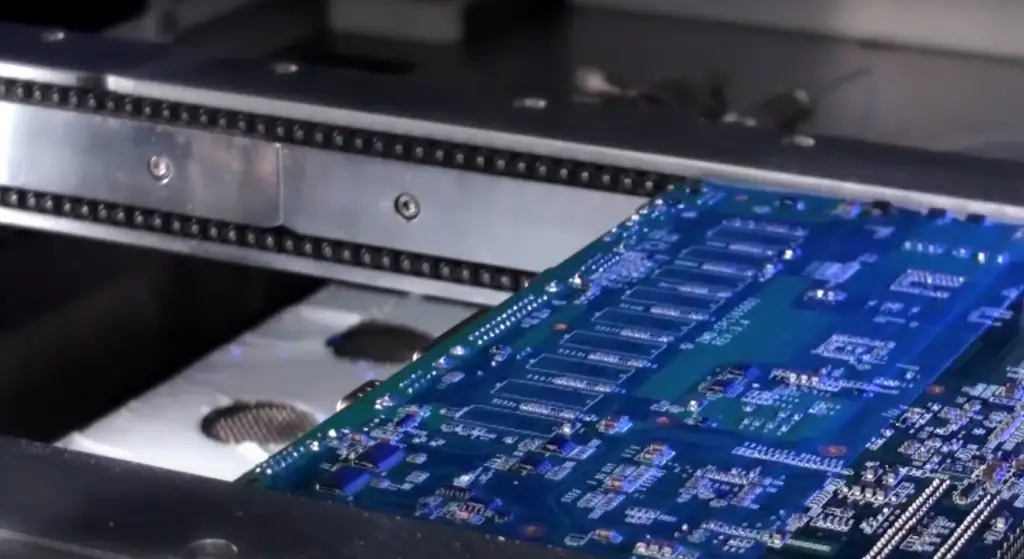
Types of Conformal Coating Manufacture:
Brush Method
The brush method is the most straightforward and commonly used method of applying conformal coatings. As the name suggests, a brush is used to apply the coating to the PCBs or electronic components. This method is often used for low-volume production or for repairing damaged coatings on PCBs.
The process involves applying the coating onto the brush and then brushing it onto the components or PCB. It is essential to ensure that the brush is clean and free of contaminants before use. This method requires patience and skill to apply the coating uniformly and avoid creating voids or leaving traces of the brush on the surface.
Spray Method
The spray method is a popular choice for high-volume production applications. This method is efficient and allows for the application of conformal coatings quickly and uniformly. The spray method involves spraying the coating onto the components or PCBs using specialized spray equipment.
The equipment used for this method varies, from handheld spray guns to automated systems that can apply the coating with high precision. The spray equipment should be chosen based on the type of coating used, the volume of production, and the required level of precision.
Dipping Method
The dipping method involves immersing the components or PCBs into a container filled with the conformal coating. This method is suitable for high-volume production and provides excellent uniformity of the coating. The dipping method is often used for components that have complex shapes or delicate features that require protection.
The process involves cleaning the components or PCBs to remove any contaminants before dipping them into the coating material. The components or PCBs are then withdrawn from the container and allowed to dry or cure as required.
Selective Coating Method
The selective coating method is a specialized method used for specific areas of a PCB or component. This method is commonly used in applications where only specific areas require protection, such as areas that come into contact with chemicals or moisture.
The selective coating method involves applying the conformal coating onto specific areas of the component or PCB using a precision dispenser. The dispenser can be programmed to apply the coating with high precision and accuracy, ensuring that the coated areas are protected while leaving the uncoated areas exposed [4].

Types of Conformal Coating:
Acrylic Resin (AR)
Acrylic Resin (AR) is one of the most widely used conformal coatings due to its excellent moisture and chemical resistance, ease of application, and relatively low cost. AR coatings are available in both solvent-based and water-based formulations and can be easily applied by spray, dip, or brush methods.
AR coatings offer good adhesion to most substrates, including PCBs, and have excellent resistance to abrasion and UV light. They are also known for their excellent flexibility, which makes them suitable for use in environments where there is significant thermal cycling.
Urethane (Polyurethane) Resin (UR)
Urethane Resin (UR), also known as Polyurethane, is another popular type of conformal coating. UR coatings offer excellent chemical and moisture resistance, making them suitable for use in harsh environments. They are available in both single-component and two-component formulations, depending on the application.
UR coatings are known for their excellent adhesion to most substrates, including PCBs, and have a relatively high degree of hardness, making them suitable for use in high-impact environments. They are also resistant to abrasion and UV light.
Silicone Resin (SR)
Silicone Resin (SR) is a highly flexible and durable conformal coating that is suitable for use in a wide range of environments. SR coatings offer excellent moisture and chemical resistance and can withstand high temperatures.
SR coatings are highly resistant to abrasion and UV light and offer excellent flexibility, making them suitable for use in environments where there is significant thermal cycling. They are also known for their low dielectric constant, making them suitable for use in high-frequency applications.
Poly-Para-Xylelene C, D, N
Poly-Para-Xylene (Parylene) is a highly effective conformal coating that is widely used in the medical, aerospace, and defense industries. Parylene coatings are highly resistant to moisture and chemicals, making them suitable for use in harsh environments.
Parylene coatings are highly conformal, meaning they can conform to complex geometries and provide a uniform thickness of the coating. They are also highly resistant to abrasion and offer excellent dielectric properties [5].
Amorphous Fluoropolymer
Amorphous Fluoropolymer is a highly effective conformal coating that is suitable for use in harsh environments. AF coatings offer excellent moisture and chemical resistance and can withstand high temperatures.
AF coatings are highly conformal and can conform to complex geometries. They are also highly resistant to abrasion and offer excellent dielectric properties. However, AF coatings can be expensive and difficult to apply.
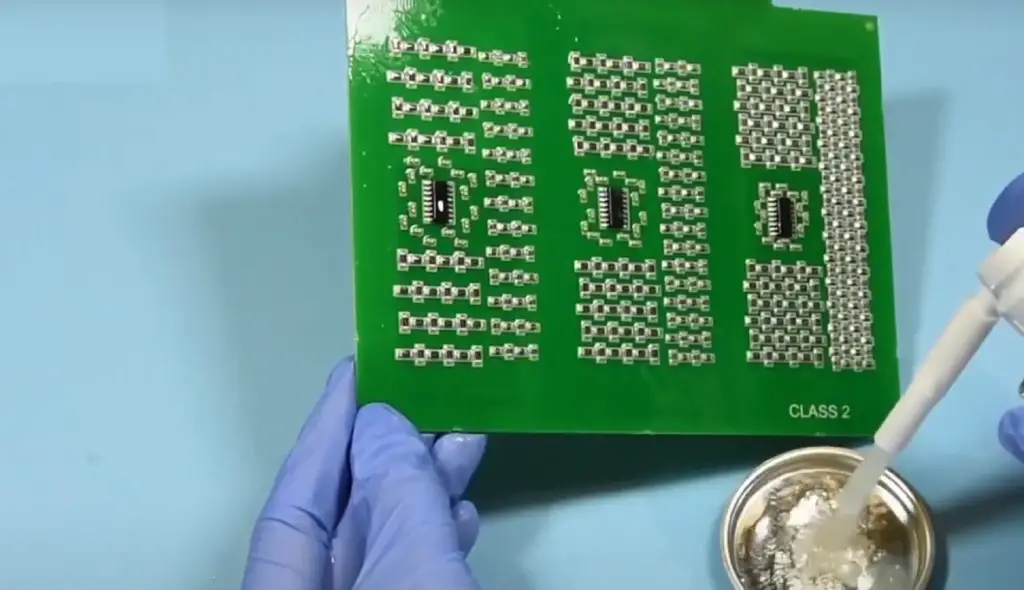
Fluorinated Poly-Para-Xylelene
Fluorinated Poly-Para-Xylene (Parylene-F) is a highly effective conformal coating that is suitable for use in harsh environments. Parylene-F coatings offer excellent moisture and chemical resistance and can withstand high temperatures.
Parylene-F coatings are highly conformal and can conform to complex geometries. They are also highly resistant to abrasion and offer excellent dielectric properties. However, Parylene-F coatings can be expensive and difficult to apply.
Water-Based Coating
Water-based conformal coatings are a more environmentally friendly alternative to solvent-based coatings. They contain little to no volatile organic compounds (VOCs), which can be harmful to human health and the environment. Water-based coatings can provide excellent protection against moisture, abrasion, and chemicals. They are also easy to apply and dry quickly, which can reduce production time.
However, water-based coatings may not provide the same level of protection as solvent-based coatings and may require additional coats for adequate protection.
UV Cure Coating
UV cure conformal coatings are a popular choice because they are fast-curing and can be applied in thin layers. The curing process occurs when the coating is exposed to ultraviolet light, which causes a chemical reaction that transforms the liquid coating into a solid film. This type of coating offers excellent adhesion and protection against chemicals and moisture. But, it can be more expensive than other types of conformal coatings, and it requires special equipment to apply and cure properly.
2K Coatings
Two-component (2K) conformal coatings consist of two separate components that are mixed together just before application. These coatings can offer excellent protection against harsh environments, and they are often used in aerospace and military applications. They can also provide superior adhesion to a wide range of substrates, including metals, plastics, and ceramics. Nevertheless, they can be more difficult to apply and require specialized equipment.
Epoxy Resin
Epoxy resin conformal coatings are a popular choice because they provide excellent protection against chemicals, moisture, and mechanical stress. They are also resistant to high temperatures, making them suitable for use in harsh environments. Epoxy coatings can be applied in a variety of thicknesses and can be used to protect a wide range of substrates. But they can be difficult to remove and require solvents or mechanical abrasives.
Hybrid Coatings
Hybrid conformal coatings combine the properties of two or more different types of coatings. For example, a hybrid coating may combine the moisture resistance of a silicone coating with the abrasion resistance of a polyurethane coating. Hybrid coatings can provide superior protection against multiple types of environmental stressors and can be tailored to meet specific application requirements. However, they can be more expensive than single-component coatings and may require specialized equipment for application.

Conformal Coating Standards
Conformal coating standards provide guidelines for the selection and application of conformal coatings to ensure that they meet specific requirements. The two most widely recognized standards for conformal coatings are IPC-A-610 and MIL-I-46058C.
It includes guidelines for the selection, application, and inspection of conformal coatings. IPC-A-610 classifies conformal coatings into three classes based on the degree of coverage required and the level of protection needed. Class 1 coatings provide basic protection against environmental stressors, while Class 3 coatings provide the highest level of protection against harsh environments [6].
It includes detailed requirements for the performance of conformal coatings under various environmental conditions. MIL-I-46058C requires that conformal coatings meet specific criteria for adhesion, resistance to moisture and chemicals, and dielectric strength. The standard also includes guidelines for testing and inspection procedures.
Other standards for conformal coatings include UL 746E, which outlines requirements for the safety of polymeric materials used in electrical equipment, and IEC 61086, which provides guidelines for the performance and testing of conformal coatings.
Adherence to these standards ensures that the conformal coatings provide the necessary level of protection against environmental stressors and meet specific performance criteria. It is important to note that compliance with these standards does not guarantee that the coating will perform optimally in every environment. Proper testing and evaluation of the coating’s performance under specific conditions are still necessary to ensure adequate protection of the electronic assembly.

Conformal Coating Testing
Conformal coating testing is an important part of the conformal coating process. The purpose of testing is to ensure that the coating performs as expected and provides the necessary level of protection against environmental stressors.
There are several tests that can be performed on conformal coatings to evaluate their performance, including:
- Adhesion testing: This test evaluates the coating’s ability to adhere to the surface of the substrate. Adhesion can be tested using methods such as crosshatch adhesion testing, tape adhesion testing, or pull-off adhesion testing;
- Dielectric strength testing: This test evaluates the coating’s ability to resist electrical breakdown under high voltage conditions. Dielectric strength can be tested using methods such as the high-voltage spark tester or the dielectric withstand tester;
- Moisture resistance testing: This test evaluates the coating’s ability to resist moisture penetration. Moisture resistance can be tested using methods such as the humidity chamber test, the salt spray test, or the water immersion test;
- Chemical resistance testing: This test evaluates the coating’s ability to resist the effects of various chemicals. Chemical resistance can be tested using methods such as the solvent rub test, the acid resistance test, or the alkali resistance test;
- Thermal cycling testing: This test evaluates the coating’s ability to withstand repeated cycles of heating and cooling. Thermal cycling testing can be performed using methods such as the thermal shock test or the thermal cycling test;
- UV resistance testing: This test evaluates the coating’s ability to resist the effects of UV radiation. UV resistance testing can be performed using methods such as the UV exposure test.
- Electrical testing: This test evaluates the coating’s ability to provide electrical insulation. Electrical testing can be performed using methods such as the insulation resistance test or the surface resistance test [7];
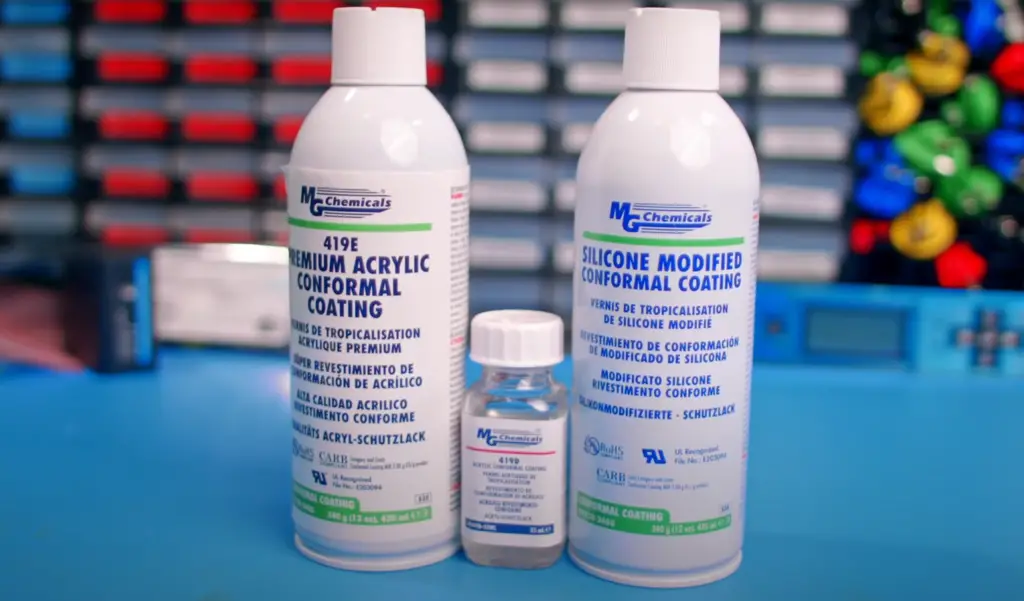
How Do I Apply a Conformal Coating?
Applying a conformal coating to an electronic device is an important step in protecting it from moisture, dust, and other contaminants.
The following are some general steps for applying a conformal coating:
- Prepare the Surface: Before applying the conformal coating, make sure the surface of the electronic device is clean and dry. Any contaminants on the surface can affect the adhesion of the coating;
- Select the Right Coating: There are different types of conformal coatings available, and each one has its own properties and application methods. Make sure to choose the coating that is appropriate for your application and is compatible with your device and other materials;
- Choose the Application Method: There are several methods for applying conformal coatings, including spray, brush, dip, and selective coating. The method you choose depends on the size and complexity of the device, the type of coating, and the volume of coating needed;
- Apply the Coating: Follow the manufacturer’s instructions for mixing and applying the coating. Be sure to apply the coating evenly and avoid excess buildup or dripping. It is also important to apply the coating in a well-ventilated area or under controlled conditions to ensure that the coating dries properly;
- Cure the Coating: Once the coating is applied, it needs to be cured according to the manufacturer’s instructions. Depending on the type of coating, this may involve heating, exposure to UV light, or natural air drying;
- Inspect the Coating: After the coating is cured, inspect it for any defects or areas that may require touch-ups. If necessary, apply additional coats or touch up any areas that require it;
How Do I Cure a Conformal Coating:
Heat Cure Coating/Evaporation Cure Coating
Heat cure coatings are typically two-part coatings that require a chemical reaction to occur between the two parts. Once the coating has been applied to the device, it is placed in a curing oven at a specific temperature and time to complete the curing process. The heat causes the chemical reaction to occur, forming a hard, protective barrier around the device.
Evaporation cure coatings work differently from heat cure coatings in that they rely on solvents to evaporate and allow the coating to cure. These coatings are typically single-part coatings that are applied to the device and allowed to dry. The solvents then evaporate, leaving a hard, protective barrier around the device.
UV Cure Conformal Coating
These coatings are applied to the device and then exposed to UV light for a specific amount of time. The UV light causes the coating to crosslink and form a hard, protective barrier around the device. These coatings are ideal for use in applications where high-speed curing is required, as they can cure within seconds.

Moisture Cure Coatings
Moisture cure coatings are single-part coatings that cure when exposed to moisture in the air. These coatings are typically used in harsh environments where exposure to high levels of moisture is expected. The coating is applied to the device and then left to cure naturally over time.
When curing conformal coatings, it is important to follow the manufacturer’s instructions carefully. Failure to do so can result in a coating that does not fully cure, compromising the protection of the device. It is also important to ensure that the curing process takes place in a clean and controlled environment to avoid contamination.
Conformal Coating Selection: Tips
- Application Method: Choose a coating that can be easily applied using your preferred method of application, whether it be brushing, spraying, or dipping;
- Environmental Factors: Consider the environmental factors that your PCB will be exposed to. This includes temperature, humidity, and exposure to chemicals, solvents, and other contaminants. The coating you choose should provide protection against these factors;
- Compatibility: Ensure that the coating is compatible with the components and materials used in your PCB assembly. Some coatings may react with certain materials, causing damage or corrosion;
- Durability: Select a coating that provides long-term protection against environmental factors and wear and tear. The durability of the coating will depend on the type of coating and the specific application;
- Cost: Consider the cost of the coating and whether it fits within your budget. Some coatings may be more expensive but offer superior protection and longevity;
- Standards: Check to see if there are any industry or regulatory standards that your PCB must adhere to. Some coatings may be required to meet specific standards for certain applications, such as medical or aerospace;
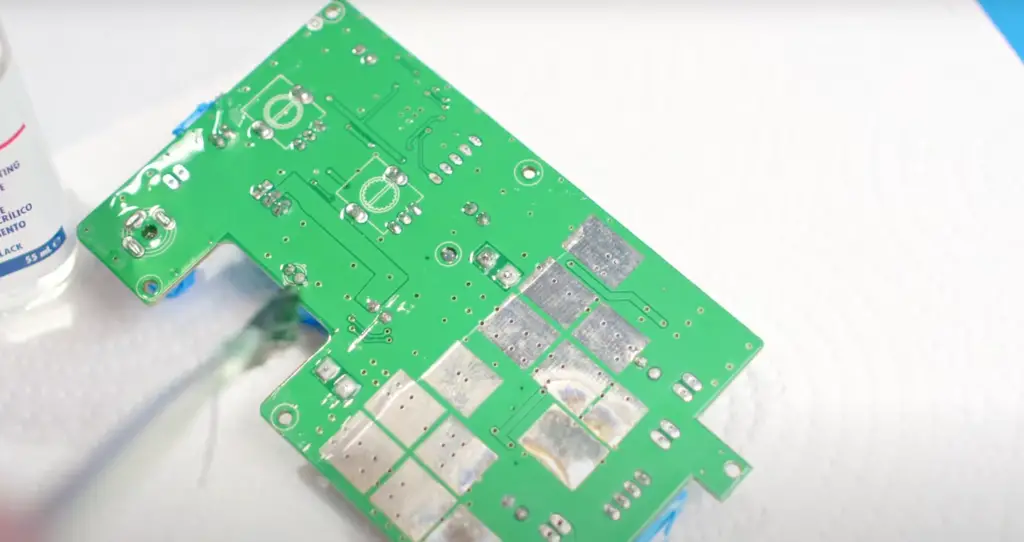
FAQ
1. How many types of conformal coating are there?
There are several types of conformal coatings available in the market. The most common types of conformal coatings are acrylics, polyurethanes, silicones, and epoxies. Each type of coating has unique properties and is suited to specific applications.
2. What is the best PCB conformal coating?
There is no one-size-fits-all answer to this question, as the best PCB conformal coating depends on the specific application requirements. Acrylic coatings are a popular choice due to their ease of application and cost-effectiveness. Polyurethane coatings offer excellent chemical resistance and UV stability, while silicone coatings provide exceptional flexibility and resistance to high temperatures [8].
3. What is the difference between 3C2 and 3C3 coating?
3C2 and 3C3 are designations used by the IPC (Institute for Printed Circuits) to define conformal coating thickness. 3C2 refers to a conformal coating with a thickness of 0.001 to 0.003 inches, while 3C3 refers to a coating with a thickness of 0.003 to 0.005 inches [9].
4. What is the best conformal coating?
There is no single “best” conformal coating, as each type has its unique properties and advantages. The choice of the best conformal coating depends on the specific application requirements.
5. Which conformal coating is better – acrylic or urethane?
Acrylic coatings are generally more cost-effective and easier to apply than polyurethane coatings. Polyurethane coatings, on the other hand, offer excellent chemical resistance and UV stability. The choice between acrylic and urethane coatings depends on the specific application requirements.
6. What is the best waterproof conformal coating?
Polyurethane coatings are generally the best choice for waterproofing PCBs, as they offer excellent moisture resistance and chemical resistance.
7. What is G3 coating on PCB?
G3 is not a specific type of conformal coating. It is a designation used by the IPC to describe a coating with a thickness of 0.0003 to 0.0005 inches.
8. What is a conformal coating for PCB standards?
Conformal coating standards define the requirements and testing procedures for conformal coatings used in PCBs. These standards ensure that conformal coatings provide adequate protection to PCBs under specific environmental conditions.
9. What are the two basics of coating?
The two basics of coating are adhesion and coverage. Adhesion refers to the ability of the coating to adhere to the surface of the PCB, while coverage refers to the ability of the coating to cover all areas of the PCB that require protection.
10. What is the most common PCB surface finish?
The most common PCB surface finish is HASL (Hot Air Solder Leveling), which involves coating the copper pads with a layer of molten solder.
11. What is the best PCB plating?
The choice of the best PCB plating depends on the specific application requirements. Some common plating options include gold plating, silver plating, and tin plating. Gold plating is commonly used for its high conductivity and resistance to corrosion, while tin plating is used for its low cost and ease of application.
12. Which coating protects PCB from moisture?
Polyurethane coatings are commonly used to protect PCBs from moisture. They provide excellent moisture resistance and also have good chemical resistance, making them ideal for harsh environments.
13. Which type of conformal coating is easy to apply and remove on PCB?
Acrylic conformal coatings are generally the easiest to apply and remove on PCBs. They dry quickly and can be easily removed using solvents, making them a popular choice for low-cost applications.
14. What are the types of acrylic conformal coating?
There are several types of acrylic conformal coatings, including single-component, two-component, and UV-curable acrylics. Each type has its unique properties and advantages, such as fast-drying time, chemical resistance, and flexibility.
15. What are examples of protective coatings?
Examples of protective coatings include epoxy coatings, polyurethane coatings, silicone coatings, and Parylene coatings. These coatings are used to protect various types of substrates from corrosion, wear and tear, and other environmental factors.
16. What is CRC coating in PCB?
CRC is a brand of conformal coating used to protect PCBs from environmental factors such as moisture, dust, and chemicals. It is a popular choice due to its ease of application and cost-effectiveness.
17. What is the cheapest material for plating in PCB?
Tin is the cheapest material for plating in PCBs. It is commonly used due to its low cost and ease of application, although it is less durable and has lower conductivity than other plating materials.
18. What are the different types of PCB etching?
Chemical etching involves using a chemical solution to remove unwanted copper from the substrate, while plasma etching uses a plasma beam to remove the unwanted copper.
19. What are the 2 characteristics of coatings?
Two important characteristics of coatings are adhesion and coverage. Adhesion refers to the ability of the coating to adhere to the substrate, while coverage refers to the ability of the coating to cover all areas of the substrate that require protection.
20. What is conformal coating IPC A 610?
IPC A 610 is a standard developed by the Institute for Printed Circuits (IPC) that defines the requirements and acceptance criteria for conformal coatings used in PCBs. It sets guidelines for the application, inspection, and testing of conformal coatings to ensure their effectiveness in protecting PCBs from environmental factors.
21. What are G2 and G3 standards?
G2 and G3 are designations used by the IPC to define conformal coating thickness. G2 refers to a conformal coating with a thickness of 1.2 to 2.5 µm, while G3 refers to a coating with a thickness of 0.8 to 1.2 µm.
22. What is the longest-lasting waterproof coating?
Fluoropolymer coatings are known for their excellent water resistance and durability. These coatings can last for many years and are often used in outdoor applications, such as building facades and bridges.
23. What is the problem with the conformal coating?
One of the main problems with the conformal coating is the difficulty of inspecting and repairing the coating. If a defect or damage occurs underneath the coating, it can be challenging to identify and repair the problem without removing the coating.
24. Which is better – epoxy or urethane?
The choice between epoxy and urethane coatings depends on the specific application requirements.
25. What is the difference between conformal coating acrylic and Parylene?
Acrylic conformal coatings are typically applied in liquid form and can be easily removed with solvents, while Parylene coatings are applied as a vapor deposition process and cannot be removed once applied. Acrylic coatings provide good protection against moisture and other environmental factors, but may not be as durable as Parylene coatings.
Parylene coatings, on the other hand, offer excellent barrier properties, high-temperature resistance, and biocompatibility, making them suitable for medical and aerospace applications. However, they are more expensive and require specialized equipment for application.
Useful Video: Overview of Conformal Coating – PCB Protection Method
References
- https://www.conro.com/conformal-coating-in-pcb-manufacturing-the-ultimate-guide/
- https://blog.matric.com/types-of-conformal-coating-pcb-protection
- https://news.ewmfg.com/blog/which-type-conformal-coating-right-my-pcb
- https://www.techspray.com/the-essential-guide-to-conformal-coating
- https://dymax.com/resources/news-and-media/blog/conformal-coating/the-different-types-of-conformal-coatings
- https://www.pcbcart.com/article/content/select-pcb-coating.html
- https://www.hzo.com/blog/how-to-choose-the-best-conformal-coating-for-your-pcb/
- https://riversideintegratedsolutions.com/best-types-of-coating-for-pcb/
- https://electrolube.com/knowledge_base/what-are-conformal-coatings/










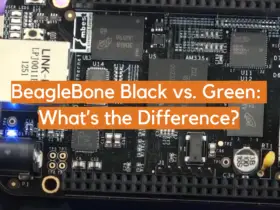


Leave a Reply